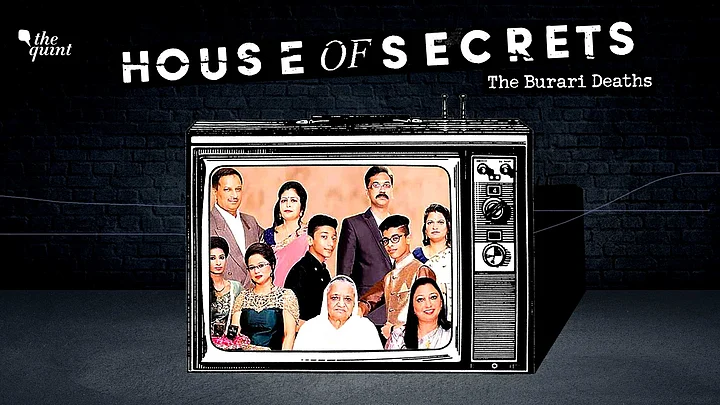(Trigger Warning: This article contains graphic elements, which may be triggering for some. Reader discretion is advised.)
Netflix's House of Secrets: The Burari Deaths left me with one phrase that not only comes the closest to explaining why a family of eleven – seemingly prosperous and happy – were suddenly found hanging from the roof of their residence in north Delhi's Burari, but also summarises why the media covered the story the way it did.
No, I am not talking about the word 'bizarre', or 'superstition', or the supposed belief in occult practices guided by a cult. The word I am talking about sounds something like 'shared psychosis.'
Now what exactly is shared psychosis?
Psychosis is a condition in which the mind loses touch with reality and may hear or see things that others do not. When the same condition is common between a group of people, it assumes the status of a shared psychosis.
Through the documentary, we now know that the Chundawat family's youngest son Lalit – who claimed to have received instructions from his late father in his dreams – was probably suffering from psychosis, which was gradually shared by other family members. But, how can a phrase that is used to symbolise a disconnect from reality be employed to describe the media coverage?
But first, let's talk about the family and the things we all missed.
The Documentary Did What Journalists Should Have
Exactly twelve days after the Chundawats were found dead inside their house, I found myself in the narrow lanes of Burari, trying to understand the damage television reportage had done to the locality's image.
Frankly speaking, I was not there to make sense of what had happened. Instead, I was trying to make sense of the media nonsense that followed in an attempt to make sense of the incident. A little like hiring a detective and then pulling a second one to spy on the first one, isn't it?
But did anyone bother to find out if any member of the family was mentally unstable? Clearly, with the news cycle, we too, moved on!
When we journalists packed out bags and left Burari, director Leena Yadav and her team arrived in the lane to make sense and not a circus of what had transpired on the night of 1 July, 2018.
Had it not been for the House of Secrets, would the lay reader have known that Lalit, on whose instructions the family tied a noose around itself, had received brain injuries from an accident around nine years before his dead father allegedly started speaking to him in his dreams?
Would we have also known that the same Lalit, who dictated what his family members should and shouldn't do – based on what the dead father said in dreams – was allegedly beaten-up and locked-up in a burning room in 2004?
That Lalit would be asleep, all night and day, in the run-up to 1 July, and had started behaving rather strangely with neighbours is also something that was not known.
Stepping away from the world of TV news coverage and its many theories, the documentary does a stellar job in throwing light on the mental condition of Lalit, whose repeated exposure to trauma cannot be discounted from the death-knell that he eventually sounded for the family.
Of Human Touch and Missed Clues
And not just a rational analysis of facts – the makers of House of Secrets did well by traveling thousands of kilometres away from epicentre Burari – first to Dhar in Madhya Pradesh, then to Tohana in Haryana – to understand how the incident left a vacuum in the lives of relatives who lost their dear ones.
We all knew that among the deceased were at least four young members of the family – but did we know what they were like? What their hobbies were? In this aspect too, House of Secrets, makes an active effort to humanise 32-year-old Maneka, whose handmade greeting cards and gifts would even put an Archies to shame.
But most importantly, what the documentary points out is a complete lack of awareness amongst masses about mental health.
It's not like the neighbours or relatives weren't in touch with the family. If anything, the family had many close friends and had even thrown a lavish engagement party for one of their daughters. How did no one know about the things that were going on in the minds of the 11?
But, can we expect the lay people to identify telling signs of deteriorating mental health, when the larger discussion around it is absent? Can they be expected to be sensitive when all they see on TV screens are re-enactments of how a certain tantrik baba may have orchestrated the entire hanging?
When TV news bulletins ask kya Burari mein aaj ki raat aatmayein wapis lautengi? (will the spirits return to Burari tonight?) and declare phansi ghar ka atma connection (house of the gallows and its connection with spirits) on prime time, instead of seeking the counsel of a psychiatrist, what effect can we expect it to have on the public's understanding of mental health?
If the family was suffering from shared psychosis, weren't our TV channels doing the same ? Isn't their reportage too far, far, far away from reality?
Of course, friends will say that the documentary wouldn't have been shot if TV news had not picked it up in the first place. True, without the kind of media glare that this non-descript lane in Burari got, the Chundawats wouldn't be subject to such close scrutiny.
But now that the makers of House of Secrets have done what Barkha Dutt calls a 'sociological autopsy' of the entire case, can we expect our news leaders to follow suit?
(This is an opinion piece and the views expressed are the author's own. The Quint neither endorses nor is responsible for them.)
